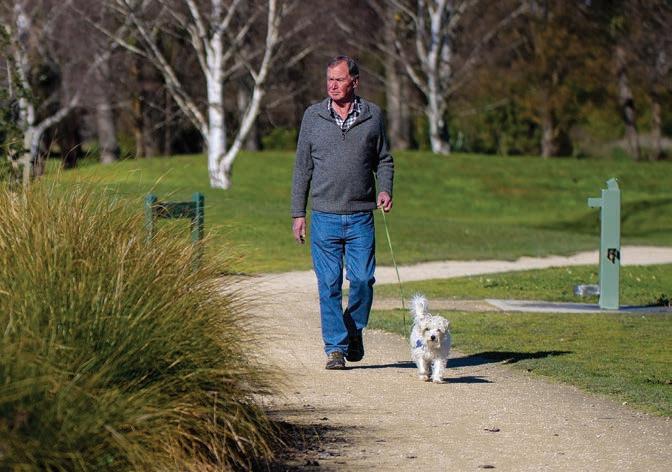
3 minute read
Extra
Accessible McCahon art at Aratoi
The foyer at Aratoi doesn’t lead only to the gallery but is a public thoroughfare with access to Entice Cafe through one door and to the Information Centre and toilets through another. The wall space between is used by Aratoi to hang artworks that give passersby, some of whom may not usually visit an art gallery, a preview of exhibitions or a taste of the treasures in the permanent collection.
Right now there are six of Aratoi’s seven Colin McCahon works there, spanning most of the 45 years of his artistic career.
Born in Timaru in 1919, McCahon spent his early years in Timaru and then Dunedin, where he attended the King Edward Technical College Art School. During the summer months he cycled from Dunedin to Nelson, to work in orchards and on tobacco farms.
Perhaps his fascination with the New Zealand landscape and geomorphology stems from then; landscapes, elemental and empty, are a feature of his work. Near Craigieburn [1969] an oil and sand painting in ochre and black is one of those.
In 1942 he married Anne Hamblett, whose portrait [1941] is also one of the paintings owned by Aratoi. The reason why only six works can be hung at any one time is because on the reverse of the portrait is a pastel, Sheds and Scaffolding, Mapua. A small watercolour of the Carter Observatory, Wellington, also dates from this time.
McCahon’s modernist style drew controversy. The work he submitted to the Otago Art Society in 1939 was excluded because it was too abstract. However, other young artists protested and it was exhibited after all.
Next McCahon moved to Nelson then Christchurch and in 1953 to Tītīrangi, eventually becoming deputy director of the Auckland Art Gallery before taking up a position as a lecturer in art at Elam.
By now he had incorporated religious themes into his work: the use of words in his paintings dated from 1940. These are represented in Aratoi’s collection by Take Away the Stone [1969] and A Poster for the Urewera [1975], the latter also showing how he drew on Māori history and tradition.
The seventh work, Poem [1975], is one of the black and white paintings we readily identify as McCahon, just as we do the dark landscapes and prophetic words he employs in other works.
A talk at Aratoi by the author of two volumes about McCahon, Peter Simpson, had to be postponed because of the lockdown. However, the paintings of this important New Zealand artist are there to see, just inside the door at Aratoi.
Colin McCahon’s art works in the Aratoi foyer. PHOTO/SUPPLIED
LETTER TO THE EDITOR Korero misunderstanding
I refer to Midweek September 15 Conversation Korero – ‘Gem has amazing potential’ authored by a member of Forest & Bird.
Having been referred to as the owner of a ‘botanical mess’ I would appreciate your publishing some correct facts.
The author of the article has totally missed the fact they are comparing the landscape of a mature native forest block with the continuing conversion of an adjacent block of recently retired dairy grazing pasture. This does not magically happen overnight.
Any research when

The earliest property improvements. PHOTO/SUPPLIED
preparing the article would have found that GRWC staff introduced insects to control the tradescantia in a sheltered initial environment. This experiment failed and was followed by an attempt by my mentor [the late Dr Neil Hayes] to control the weed by spraying. This also failed as a result of the death of adjacent plantings.
Further research would have found the” willows encroaching on the lagoon” are tangoio poles sourced from the GRWC erosion control nursery to replace the “crack willow” in erosion protection when the Ruamahanga River flows through the lagoon when in flood.
The “pine slash covered in blackberry” is a work in progress awaiting stump rotting such that a dozer can be used, without damage to undercarriage, prior to disposal by safe burning.
Some ninety per cent of the subject land is now planted in natives.
I regret that such conservation efforts are not appreciated by Forest & Bird.
Barry Silvester, QEII covenantor Greytown
DURING LEVEL 2, WALK THIS WAY
Our dogs will be loving the freedom of Level 2, but remember, at Level 2 Delta: y You should walk your dog on a leash at all times, even in designated
‘off-leash’ areas. This will minimise the chances of you needing to break your ‘bubble’ to retrieve your pet. y If other people are around, wear a mask.


